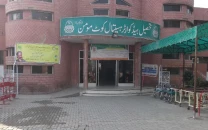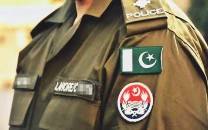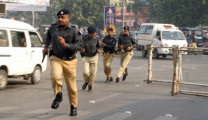Stocked shelves and empty seats
Fewer people reading Quaid-i-Azam library’s aging books.

Stocked shelves and empty seats
But the number doing so has gotten much smaller, says Shaukat, a guard there. “There were never many people who came here but now the numbers have dwindled to hardly three or four a week,” he says.
Quaid-i-Azam Library is one of the largest and best stocked libraries in the country. Constructed during British rule in the middle of the 19th century, it is located in the famous Lawrence Gardens and, despite the newly constructed maze of obstructions and barbed wire around it, still commands attention.
But of late the library has begun to take on the appearance of a relic. As I make my way into the stuffy building with its magnificent turquoise in-lay ceiling, it becomes clear that the library owes its barrenness, in part at least, to the weather. On this Wednesday, there are four people, including myself, sitting and studying in the stifling humidity. It is not a lending library and essentially caters to students and researchers.
Imran Durrani, a Government College student, is slightly agitated at being interrupted while perusing a copy of Manto’s greatest works. He says he tries to make a weekly visit to the library. “I do realise that I am part of a dying breed. It is hard to study when one is practically broiling. Moreover this place hardly ever gets new shipments, or at least new shipments of the latest titles,” he says. “Still, I can’t help coming here. It’s the only place I can study and the fact that few come here practically guarantees that it will be quiet.
“I also like the fact that inevitably, one of the desk in-charges [usually a Mr Dar, who is not in today] will ask me about my work and my interests and genuinely want to hear me speak about my subject,” he says. Imran is working on a comparison of Manto’s essays with the works of Russian authors for his English literature course.
Quaid-i-Azam Library is not the ideal destination for those looking to research new and cutting edge topics. The two halls of the library, Lawrence Hall and Montgomery Hall, host a massive collection of old books. The journal subscription list is infrequently updated and the audio and visual aids, as well as the computer section, are in serious need of sprucing up. But the library has an impressive collection of classics, theology and political science books.
“I come here mostly out of habit. I can’t study anywhere else but in a library and this one still has the largest selection to choose from.
I miss foreign libraries such as the one at my university in the US but this is the closest thing,” says Qasim Hayat, a former Punjab University student currently working on a psychology paper titled ‘Suicide bombing: desperation or determination’. “Also, I like the fact that the guides and desk people always know where the books are. This is something that I always find frustrating at bookstores in Lahore. One can go to the snazziest book store and the attending won’t even know who Karl Marx or Plato is,” he adds. A group of gardeners sitting outside the library keenly inspect each person that walks in and out of the stiff entrance doors (now located at the back of the building for security reasons). “I hope your studies go well. We seldom see new faces here and I don’t understand why that is,” says Amanat, one of the gardeners. “I cannot read and my children cannot read but there are so many books here and I sometimes get to clean them. I don’t understand why those who can read don’t come here and do that more often. They don’t realise how blessed they are.”
Looking back…
Lawrence Hall and Montgomery Hall were built in 1861-62 to commemorate Sir John Lawrence’s association with the Punjab. Lawrence was the first lieutenant governor of the Punjab and subsequently served as viceroy and governor general of India. Montgomery Hall was built in 1866 with donations from native chiefs of the Punjab in honour of Sir Robert Montgomery. The two halls are joined by a covered corridor and a recently constructed commodious reading-room leads into the corridor between the two halls. The building was used as an assembly room for public meetings and theatrical and musical performances in the late 1800s. Mostly it was a meeting place for the foreign elite to while away their evenings in summer with iced drinks and in winter with a log-fire. The building was known as Old Gymkhana. Gen Ziaul Haq visited Bagh-e-Jinnah to approve the plan to set up a library there on October 24, 1981. It was officially inaugurated by the then president on December 25, 1984 and named the Quaid-i-Azam Library.
Published in The Express Tribune, November 9th, 2010.



















COMMENTS
Comments are moderated and generally will be posted if they are on-topic and not abusive.
For more information, please see our Comments FAQ